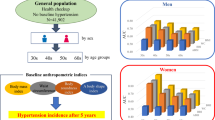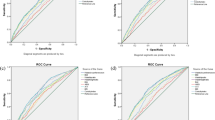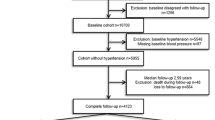Abstract
We compared the predictive capability of weight, waist circumference (WC), waist-to-height ratio (WHtR), waist-to-hip ratio (WHR), body mass index (BMI), body roundness index (BRI), and a body shape index (ABSI) to identify incident hypertension, and to determine whether any of these indices may be used as a better single predictor of incident hypertension. A total of 1718 participants aged 39–72 years were collected in a longitudinal study. Logistic regression models were used to evaluate various anthropometric indices as significant predictors of hypertension. During 2.8 years of follow-up, 185 new cases of hypertension (10.8%) were reported. The BRI and ABSI were significantly higher in the participants who had developed hypertension than in those who had not (4.15 ± 1.01 vs. 3.57 ± 1.03, 0.80 ± 0.04 vs. 0.78 ± 0.05; respectively, p < 0.001). After adjusting for confounding variables, logistic regression analysis indicated that participants within the highest quartile of WC and WHtR were 4.79 and 4.51 times more likely to have hypertension than those within the lowest quartile (OR 4.79, 95% CI 2.49–9.20 vs. OR 4.51, 95% CI 2.41–8.43, respectively, p < 0.0001); in contrast, no such correlation was found for BMI, WHR, BRI, and ABSI. WC (AUC: 0.672) showed a more powerful predictive ability for hypertension (p < 0.0001) than BMI (AUC: 0.623), and an equal predictive power for hypertension as WHtR (AUC: 0.662) and BRI (AUC: 0.662) in the general population. We concluded that WC and/or WHtR but not BMI, showed superior prediction capability compared to WHR, BRI, and ABSI, for determining the incidence of hypertension in a community-based prospective study.
This is a preview of subscription content, access via your institution
Access options
Subscribe to this journal
Receive 12 digital issues and online access to articles
$119.00 per year
only $9.92 per issue
Buy this article
- Purchase on Springer Link
- Instant access to full article PDF
Prices may be subject to local taxes which are calculated during checkout

Similar content being viewed by others
References
Chung IH, Park S, Park MJ, Yoo EG. Waist-to-height ratio as an index for cardiometabolic risk in adolescents: results from the 1998-2008 KNHANES. Yonsei Med J. 2016;57:658–63.
Chei CL, Iso H, Yamagishi K, Tanigawa T, Cui R, Imano H, et al. Body fat distribution and the risk of hypertension and diabetes among Japanese men and women. Hypertens Res. 2008;31:851–7.
Fuchs FD, Gus M, Moreira LB, Moraes RS, Wiehe M, Pereira GM, et al. Anthropometric indices and the incidence of hypertension: a comparative analysis. Obes Res. 2005;13:1515–7.
Hsieh SD, Muto T. The superiority of waist-to-height ratio as an anthropometric index to evaluate clustering of coronary risk factors among non-obese men and women. Prev Med. 2005;40:216–20.
Ho SC, Chen YM, Woo JL, Leung SS, Lam TH, Janus ED. Association between simple anthropometric indices and cardiovascular risk factors. Int J Obes Relat Metab Disord. 2001;25:1689–97.
Dobbelsteyn CJ, Joffres MR, MacLean DR, Flowerdew G. A comparative evaluation of waist circumference, waist-to-hip ratio and body mass index as indicators of cardiovascular risk factors. The Canadian Heart Health Surveys. Int J Obes Relat Metab Disord. 2001;25:652–61.
Hsieh SD, Yoshinaga H, Muto T. Waist-to-height ratio, a simple and practical index for assessing central fat distribution and metabolic risk in Japanese men and women. Int J Obes Relat Metab Disord. 2003;27:610–6.
Son YJ, Kim J, Park HJ, Park SE, Park CY, Lee WY, et al. Association of waist-height ratio with diabetes risk: A 4-year longitudinal retrospective study. Endocrinol Metab. 2016;31:127–33.
Madruga JG, Moraes Silva F, Scherer Adami F. Positive association between waist-to-height ratio and hypertension in adolescents. Rev Port Cardiol. 2016;35:479–84.
Browning LM, Hsieh SD, Ashwell M. A systematic review of waist-to-height ratio as a screening tool for the prediction of cardiovascular disease and diabetes: 0.5 could be a suitable global boundary value. Nutr Res Rev. 2010;23:247–69.
Khoury M, Manlhiot C, McCrindle BW. Role of the waist/height ratio in the cardiometabolic risk assessment of children classified by body mass index. J Am Coll Cardiol. 2013;62:742–51.
Maffeis C, Banzato C, Talamini G. Waist-to-height ratio, a useful index to identify high metabolic risk in overweight children. J Pediatr. 2008;152:207–13.
Ashwell M, Hsieh SD. Six reasons why the waist-to-height ratio is a rapid and effective global indicator for health risks of obesity and how its use could simplify the international public health message on obesity. Int J Food Sci Nutr. 2005;56:303–7.
Rosenthal AD, Jin F, Shu XO, Yang G, Elasy TA, Chow WH, et al. Body fat distribution and risk of diabetes among Chinese women. Int J Obes Relat Metab Disord. 2004;28:594–9.
Tulloch-Reid MK, Williams DE, Looker HC, Hanson RL, Knowler WC. Do measures of body fat distribution provide information on the risk of type 2 diabetes in addition to measures of general obesity? Comparison of anthropometric predictors of type 2 diabetes in Pima Indians. Diabetes Care. 2003;26:2556–61.
Bohr AD, Laurson K, McQueen MB. A novel cutoff for the waist-to-height ratio predicting metabolic syndrome in young American adults. BMC Public Health. 2016;16:295.
Savva SC, Lamnisos D, Kafatos AG. Predicting cardiometabolic risk: waist-to-height ratio or BMI. A meta-analysis. Diabetes Metab Syndr Obes. 2013;6:403–19.
Chang Y, Guo X, Chen Y, Guo L, Li Z, Yu S, et al. A body shape index and body roundness index: two new body indices to identify diabetes mellitus among rural populations in northeast China. BMC Public Health. 2015;15:794.
Krakauer NY, Krakauer JC. A new body shape index predicts mortality hazard independently of body mass index. PLoS ONE. 2012;7:e39504.
Thomas DM, Bredlau C, Bosy-Westphal A, Mueller M, Shen W, Gallagher D, et al. Relationships between body roundness with body fat and visceral adipose tissue emerging from a new geometrical model. Obesity. 2013;21:2264–71.
He S, Chen X. Could the new body shape index predict the new onset of diabetes mellitus in the Chinese population? PLoS ONE. 2013;8:e50573.
Krakauer NY, Krakauer JC. Dynamic association of mortality hazard with body shape. PLoS ONE. 2014;9:e88793.
Haghighatdoost F, Sarrafzadegan N, Mohammadifard N, Asgary S, Boshtam M, Azadbakht L. Assessing body shape index as a risk predictor for cardiovascular diseases and metabolic syndrome among Iranian adults. Nutrition. 2014;30:636–44.
Maessen MF, Eijsvogels TM, Verheggen RJ, Hopman MT, Verbeek AL, de Vegt F. Entering a new era of body indices: the feasibility of a body shape index and body roundness index to identify cardiovascular health status. PLoS ONE. 2014;9:e107212.
Zhou Z, Hu D, Chen J. Association between obesity indices and blood pressure or hypertension: which index is the best? Public Health Nutr. 2009;12:1061–71.
DeLong ER, DeLong DM, Clarke-Pearson DL. Comparing the areas under two or more correlated receiver operating characteristic curves: a nonparametric approach. Biometrics. 1988;44:837–45.
Chung W, Park CG, Ryu OH. Association of a New Measure of Obesity with Hypertension and Health-Related Quality of Life. PLoS ONE. 2016;11:e0155399.
Oreopoulos A, Padwal R, McAlister FA, Ezekowitz J, Sharma AM, Kalantar-Zadeh K, et al. Association between obesity and health-related quality of life in patients with coronary artery disease. Int J Obes. 2010;34:1434–41.
Heymsfield SB, Scherzer R, Pietrobelli A, Lewis CE, Grunfeld C. Body mass index as a phenotypic expression of adiposity: quantitative contribution of muscularity in a population-based sample. Int J Obes. 2009;33:1363–73.
Saeed AA, Al-Hamdan NA. Anthropometric risk factors and predictors of hypertension among Saudi adult population-a national survey. J Epidemiol Glob Health. 2013;3:197–204.
Ashwell M, Gunn P, Gibson S. Waist-to-height ratio is a better screening tool than waist circumference and BMI for adult cardiometabolic risk factors: systematic review and meta-analysis. Obes Rev. 2012;13:275–86.
Jousilahti P, Tuomilehto J, Vartiainen E, Pekkanen J, Puska P. Body weight, cardiovascular risk factors, and coronary mortality. 15-year follow-up of middle-aged men and women in eastern Finland. Circulation. 1996;93:1372–9.
Wilson PW, D’Agostino RB, Sullivan L, Parise H, Kannel WB. Overweight and obesity as determinants of cardiovascular risk: the Framingham experience. Arch Intern Med. 2002;162:1867–72.
Fujita M, Sato Y, Nagashima K, Takahashi S, Hata A. Predictive power of a body shape index for development of diabetes, hypertension, and dyslipidemia in Japanese adults: a retrospective cohort study. PLoS ONE. 2015;10:e0128972.
Acknowledgements
This research was supported by the Basic Science Research Program through the National Research Foundation of Korea (NRF) funded by the Ministry of Education (2017R1D1A3B03034119). This study was supported by Korea Centers for Disease Control and Prevention (2005-E71013-00, 2006-E71002-00, 2007-E71013-00, 2008-E71004-00, 2009-E71006-00, and 2010-E71003-00). This research was supported by Medical Research Center Program 2017R1A5A2015369.
Author information
Authors and Affiliations
Corresponding author
Ethics declarations
Conflict of interest
The authors declare that they have no conflict of interest.
Rights and permissions
About this article
Cite this article
Choi, J.R., Ahn, S.V., Kim, J.Y. et al. Comparison of various anthropometric indices for the identification of a predictor of incident hypertension: the ARIRANG study. J Hum Hypertens 32, 294–300 (2018). https://doi.org/10.1038/s41371-018-0043-4
Received:
Revised:
Accepted:
Published:
Issue Date:
DOI: https://doi.org/10.1038/s41371-018-0043-4
This article is cited by
-
Relationship between novel anthropometric indices and the incidence of hypertension in Chinese individuals: a prospective cohort study based on the CHNS from 1993 to 2015
BMC Public Health (2023)
-
The relationship between anthropometric indices and the presence of hypertension in an Iranian population sample using data mining algorithms
Journal of Human Hypertension (2023)
-
Comparison of bioelectrical body and visceral fat indices with anthropometric measures and optimal cutoffs in relation to hypertension by age and gender among Chinese adults
BMC Cardiovascular Disorders (2021)
-
Predicting value of five anthropometric measures in metabolic syndrome among Jiangsu Province, China
BMC Public Health (2020)
-
Association between serotonin 2A receptor (HTR2A) genetic variations and risk of hypertension in a community-based cohort study
BMC Medical Genetics (2020)



